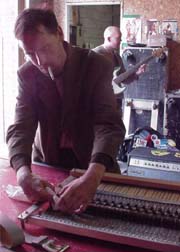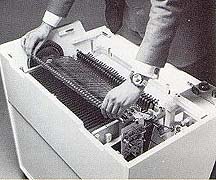- Don's Mellotron Page:
The Mellotron is an electronic musical instrument invented around 1960 to provide the sounds of violins, cellos, flutes, choirs, horns, pretty much anything, from a keyboard. Given the technology of the day, the reasonable way to do this was with strips of magnetic tape. So the Mellotron uses a strip of magnetic tape, a pinch roller, tape head, pressure pad, and a rewind mechanism for each note on the keyboard.
To our modern day technological sensibilities this cumbersome mechanical contraption seems kludgy as can be, especially you're watching the tape rewind operation, but the fact is that no modern technology keyboard can come close to the quality of presence so characteristic of the Mellotron sound. Why is this? Because the tape playback mechanism is the musical instrument. It matters less what is recorded on the tape.
You can hear the Mellotron on almost every song on the main seven Moody Blues albums, on The Beatles' "Strawberry Fields", and on many albums by Genesis, King Crimson, The Strawbs and Yes. The instrument was, and still is, a centerpiece of the progressive rock movement.
• Don's Mellotron Page by J Donald Tillman
- Mellotron History:
Popular music and its culture has given us many famous instrument innovations. The electric guitar, the Rhodes Piano and the synthesizer quickly come to mind. Our capacity for invention seems at times to be limitless when a problem stands between us and our artistic vision. One problem facing all musicians at one time or another is the matter of artistic control and the ability to realize a sound without having the facility to play the instrument responsible for that sound. Multi-track recording gave a single musician the ability to manipulate time by overdubbing a performance to create a multi instrument piece of music but, he still was faced with learning and playing those instruments himself. A major driving force for today's music industry, to be sure.
• http://www.mellotron.com
- Jim Smith's Mellotron Page:
The Mellotron was perhaps the first polyphonic "synthesizer" to be made available to the masses of musical performers who did not intend to haul around a real piano or orchestra. The unit is rather large - smaller than a string section though.
It works like this. For every key on the console there is, essentially, a tape player. When a key is pressed a mechanism is engaged which pulls a pre-recorded tape across the head. When the key is released a spring "instantly" yanks the tape back - hopefully before the key is pressed again. Wal-La - a sample player. But that's not all...
These tape loops came in racks that could be interchanged so one minute your Mellotron would be a string ensamble and the next - an organ or piano. I don't know how long it actually took to swap a rack but I know allignment was sometimes a problem. I doubt anyone tried this live.
The Mellotron, as mechanical and absurd as it was, was the only choice many musicians had if they wanted more than two finger chords on a synthesizer - until, of course, the ARP String Ensamble hit the market - so-long mellotron.
• Jim Smith's Mellotron Page
- The First Sampler:
Launched in 1963, the Mellotron was the first music sampler - an instrument that can capture and play back other sounds. The music press described it as a 'Rolls Royce' instrument - a Mellotron cost as much as the average grand piano. Designed and built before the days of digital technology, the instrument was based on a stunningly complex array of seventy tape machines. A separate tape player was connected to every key of the instrument. Each tape contained a sample (in fact, a direct tape recording) of several different instruments. At the flick of a switch, a player could reposition each tape to play a flute, trumpet, accordion or other sampled (tape recorded) instrument polyphonically.
• The Mellotron - The First Music Sampler by Sarah Angliss
- The Mellotron - A Potted History:
Although originally designed as a 'home entertainment' keyboard by the mid-sixties the Mellotron was starting to appear on contemporary rock/pop records. A few of the many users of note have included The Beatles, Yes (Rick Wakeman burnt his!), Genesis, Tangerine Dream, King Crimson, Moody Blues, Manfred Mann, Strawbs, Traffic, Led Zeppelin, Rolling Stones, Gentle Giant, Jethro Tull, Larry Fast (says he still has it), Jean Michel Jarre, Barclay James Harvest...
• http://www.keyboardmuseum.com
- The Mellotron - How It Works:
The Mellotron is a sample replay machine but as it was developed in the early 1960's, before the invention of solid-state memory, floppy discs or microprocessors, it used lengths of recording tape to store each 'sample'...
• The Mellotron - How It Works by Norm Leete
- Webster's Dictionary Definition:
The Mellotron (and its direct ancestor the Chamberlin) were in effect the world's first sample-playback keyboards. The heart of the instrument is a bank of parallel linear (not looped) strips of magnetic tape (aprox 8 seconds of playing time); playback heads underneath (but not directly underneath) each key enable performers to play the pre-recorded sound assigned to that key when pressed. The earlier MKI, and MKII models contained two side by side keyboards with 18 selectable sets of specially-recorded sounds on the right keyboard such as strings, flutes, and brass instruments wich where called "lead", or "instrument" sounds, and pre-recorded accompaniment music (in various styles) on the left keyboard. The tape banks for the later, and lighter M400 models contain three selectable sounds (per changable taperack) such as strings, cello, and the famous eight voice choir. The sound on each individual tape piece is recorded at the specific pitch of the key that it was assigned to.
• http://www.webster-dictionary.org
- The Mellotron:
Each strip of tape had three sounds on it (one of the most popular combinations being strings, choir and flute) selectable from a rotary switch on the panel to the left of the small three octave keyboard but other frames could be purchased and swapped over if you wanted. This was a 'simple' matter of lifting the lid off the unit, removing the keyboard assembly, undoing a few screws, lifting out the tape frame and replacing it with the other frame, tightening the screws and replacing the keyboard assembly and top lid!!! The instrument was also very temperamental and required regular servicing.
• The Mellotron by Steve Howell
- The Chamberlin:
The Chamberlin was invented in the US in 1946 by Harry Chamberlin who had the idea (allegedly) when setting up his portable tape recorder to record himself playing his home organ. It is rumoured that it occured to him that if he could record the sound of a real instrument, he could make a keyboard instrument that could replay the sound of real instruments and thus the Chamberlin was born.
• The Chamberlin by Steve Howell
- Mellotron Background:
The Mellotron is perhaps most famous for its use on The Beatles' "Strawberry Fields Forever", and was also used by The Zombies, the Moody Blues, The Rolling Stones and others during the psychedelic era. It was also widely used to provide backing keyboard harmonies for many of the progressive rock albums of the 1970s, notably "Foxtrot" by Genesis, "In the Court of the Crimson King" by King Crimson and "Kashmir" by Led Zeppelin.
• Mellotron Background at Serebella
- The Mellotron Story:
All Mellotrons are based on the principal invented by Harry Chamberlin,where each key simply sets a length of tape in motion, playing back whatever was recordedon the tape. They were thus the predecessors of sample playback machines. User sampling wasn't impossible, either - but generally involved recording what you wanted andsending it to the Mellotron factory to be converted into a rack of tapes for your machine (at least one machine was built which actually recorded as well as playing back some of the tapes, but it never went into commercial production; and there was also an option available for the 400 which enabled you to record and use your own quarter-inch tapes). In a foretaste of how samplers evolved, early Mellotrons would have a bank of backing tracks and percussion tracks, like loops today, as well as multi-sampled lead/chordal instruments.
• The Mellotron Story by Peter Forrest
- Rebirth of The Cool SOUND ON SOUND - August 2002:
The Mellotron has had a chequered history, from '60s "must-have" to '80s "has-been" but it's survived bankruptcy and technological progress, and now it's back, in a brand-new, reworked form. We relate the story of this classic instrument, and see how the new version compares to the old.
• Mellotron Mk IV Review SOUND ON SOUND by Gordon Reid
- Streetly Electronics:
Streetly Electronics is run by John Bradley and Martin Smith. This duo claims to be the only people on the planet who can offer a full renovation package for all models of Mellotrons and Novatrons. Through their efforts they are helping people re-discover the instrument's unique sound and aiding in its revival.
• Streetly Electronics
- Mellotron Mk IV:
In 1991, David Kean purchased the rights to the Mellotron name and the tape-making equipment from the man who had bought the assets of the short-lived and by then defunct Mellotron Digital. Kean then established a new company that he called Mellotron Archives. Initially supplying tapes and spare parts, Kean and fellow enthusiast Markus Resch later provided servicing, and produced digitally remastered, and in some cases, 'cleaned up' sets of Mellotron and Chamberlin sounds. They also released a CD-ROM of sampled Mellotrons and Chamberlins. Their website is a source for instrument information, new and used instruments as well as replacement parts for Mellotrons and Chamberlins - and includes info on the Mellotron Mk VI, the first new production of Mellotrons in over 15 years, providing the classic look and sound of the Mellotron 400 with dozens of technical improvements.
• http://www.mellotron.com

 On Saturday 11 December 2004 at 8:00pm The Gatherings Concert Series will present a Mellotron Workshop at St. Mary's Hamilton Village. This workshop is open to anyone interested in learning more about the concepts upon which this instrument is based. If you have ever listened to music which included the sounds of the classic mighty Mellotron keyboard and become curious about how it functions and is used to create music, then this workshop is for you!
On Saturday 11 December 2004 at 8:00pm The Gatherings Concert Series will present a Mellotron Workshop at St. Mary's Hamilton Village. This workshop is open to anyone interested in learning more about the concepts upon which this instrument is based. If you have ever listened to music which included the sounds of the classic mighty Mellotron keyboard and become curious about how it functions and is used to create music, then this workshop is for you!
 Mellotron Overview
Mellotron Overview




 2
2  3
3 
 5
5 